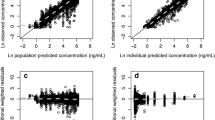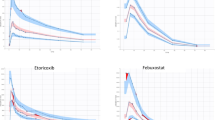Abstract
Purpose
The pharmacokinetics of simvastatin is complex with multiple peaks in the absorption phase, which cannot be adequately described by a conventional first order absorption model. The biotransformation of simvastatin into simvastatin acid, an active metabolite, is reversible. This study evaluated the pharmacokinetics of simvastatin and simvastatin acid, focusing on the absorption kinetics.
Methods
Data were collected from three bioequivalence studies, in which subjects were administered 60 mg simvastatin, and from one crossover study, in which subjects were administered two doses randomly selected from 10, 20, 30, 40 to 80 mg simvastatin with washout period. The pharmacokinetics of simvastatin was assessed in 133 healthy males. Plasma concentrations of simvastatin and simvastatin acid were measured in 2,182 and 2,130 samples, respectively, and the pharmacokinetic data were analyzed using NONMEM.
Results
The time course of changes in the plasma simvastatin concentration was best described by a two-compartment linear model with three parallel absorption processes, each of which consisted of mixed zero-and first order absorption. Additions of inter-occasional variability to the absorption parameters significantly improved the model’s fit. The disposition parameter estimates were significantly different when different absorption models were applied, indicating the importance of the appropriate absorption modeling. Pharmacokinetic modeling preferred the inter-conversion between simvastatin and simvastatin acid.
Conclusion
A pharmacokinetic model describing the complex, multiple peak, absorption kinetics of simvastatin was formulated using three parallel, mixed zero and first-order absorptions. This type of absorption model may be applicable to other drugs that show irregular, multiple-peak concentrations during their absorption phase.




Similar content being viewed by others
Abbreviations
- A(n):
-
Amount of drug in nth compartment
- ALAGn:
-
Absorption lag from nth compartment
- CL:
-
Clearance
- CV:
-
Coefficient of variation
- Dn:
-
Duration of zero order administration to nth Depot compartment
- FM:
-
Fraction that is metabolized to simvastatin acid of total clearance of simvastatin
- Fn:
-
Bioavailability to nth depot compartment
- FOCE:
-
First-order conditional estimation
- GOF:
-
Goodness-of-fit
- HMG-CoA:
-
3-hydroxy-3-methylglutaryl coenzyme A
- IIV:
-
Inter-individual variability
- IOV:
-
Inter-occasional variability
- K:
-
Transfer rate constant between pharmacokinetic compartment
- Ka:
-
Absorption rate constant
- LLOQ:
-
Lower limit of quantification
- LOWESS:
-
Locally weighted scatterplot smoothing
- MAP:
-
Maximum a posteriori probability
- OFV:
-
Objective function value
- Q:
-
Inter-compartmental clearance between central and peripheral compartment
- Vd:
-
Volume of distribution
References
Alberts AW, Chen J, Kuron G, Hunt V, Huff J, Hoffman C, et al. Mevinolin: a highly potent competitive inhibitor of hydroxymethylglutaryl-coenzyme A reductase and a cholesterol-lowering agent. Proc Natl Acad Sci U S A. 1980;77:3957–61.
Prueksaritanont T, Subramanian R, Fang X, Ma B, Qiu Y, Lin JH, et al. Glucuronidation of statins in animals and humans: a novel mechanism of statin lactonization. Drug Metab Dispos. 2002;30:505–12.
Prueksaritanont T, Qiu Y, Mu L, Michel K, Brunner J, Richards KM, et al. Interconversion pharmacokinetics of simvastatin and its hydroxy acid in dogs: effects of gemfibrozil. Pharm Res. 2005;22:1101–9.
Merck Sharpe & Dohme. Manufacturer Information, Zocor: simvastatin. PA: West Point; 1991.
Kim J, Ahn BJ, Chae HS, Han S, Doh K, Choi J, et al. A Population Pharmacokinetic-PharmacodynamicModel for Simvastatin that Predicts Low-Density Lipoprotein-Cholesterol Reduction in Patients with Primary Hyperlipidaemia. Basic Clin Pharmacol Toxicol. 2011;109:156–63.
Mahmood I. Pharmacokinetic analysis of the absorption characteristics of diclofenac sodium in man by use of a multi-segment absorption model. J Pharm Pharmacol. 1996;48:1260–3.
Huang SM, Marriott TB, Weintraub HS, Arnold JD, Boccagno J, Abels R, et al. Clinical pharmacokinetics of etintidine. Biopharm Drug Dispos. 1988;9:477–86.
Lee SH, Lee MG, Kim ND. Pharmacokinetics and pharmacodynamics of bumetanide after intravenous and oral administration to rats: absorption from various GI segments. J Pharmacokinet Biopharm. 1994;22:1–17.
Dixon R, Warrander A. The clinical pharmacokinetics of zolmitriptan. Cephalalgia. 1997;17 Suppl 18:15–20.
Ezzet F, Krishna G, Wexler DB, Statkevich P, Kosoglou T, Batra VK. A population pharmacokinetic model that describes multiple peaks due to enterohepatic recirculation of ezetimibe. Clin Ther. 2001;23:871–85.
Funaki T. Enterohepatic circulation model for population pharmacokinetic analysis. J Pharm Pharmacol. 1999;51:1143–8.
Plusquellec Y, Efthymiopoulos C, DuthilP HG. A pharmacokinetic model for multiple sites discontinuous gastrointestinal absorption. Med Eng Phys. 1999;21:525–32.
Lennernas H, Regardh CG. Dose-dependent intestinal absorption and significant intestinal excretion (exsorption) of the beta-blocker pafenolol in the rat. Pharm Res. 1993;10:727–31.
Oberle RL, Amidon GL. The influence of variable gastric emptying and intestinal transit rates on the plasma level curve of cimetidine; an explanation for the double peak phenomenon. J Pharmacokinet Biopharm. 1987;15:529–44.
Savic RM, Jonker DM, Kerbusch T, Karlsson MO. Implementation of a transit compartment model for describing drug absorption in pharmacokinetic studies. J Pharmacokinet Pharmacodyn. 2007;34:711–26.
Murata K, Noda K, Kohno K, Samejima M. Pharmacokinetic analysis of concentration data of drugs with irregular absorption profiles using multi-fraction absorption models. J Pharm Sci. 1987;76:109–13.
Wade JR, Kelman AW, Howie CA, Whiting B. Effect of misspecification of the absorption process on subsequent parameter estimation in population analysis. J Pharmacokinet Biopharm. 1993;21:209–22.
Jemal M, Ouyang Z, Powell ML. Direct-injection LC-MS-MS method for high-through put simultaneous quantitation of simvastatin and simvastatin acid in human plasma. J Pharm Biomed Anal. 2000;23:323–40.
Zhang L, Beal SL, Sheiner LB. Simultaneous vs. sequential analysis for population PK/PD data I: best-case performance. J Pharmacokinet Pharmacodyn. 2003;30:387–404.
Ette EI, Williams PJ. Pharmacometrics: The Science of Quantitative Pharmacology. New York: Wiley-Interscience; 2007.
Karlsson MO, Sheiner LB. The importance of modeling interoccasion variability in population pharmacokinetic analyses. J Pharmacokinet Biopharm. 1993;21:735–50.
Vickers S, Duncan CA, Chen IW, Rosegay A, Duggan DE. Metabolic disposition studies on simvastatin, a cholesterol-lowering prodrug. Drug Metab Dispos. 1990;18:138–45.
Miller R. Pharmacokinetics and bioavailability of ranitidine in humans. J Pharm Sci. 1984;73:1376–9.
Ogasawara A, Utoh M, Nii K, Ueda A, Yoshikawa T, Kume T, et al. Effect of oral ketoconazole on oral and intravenous pharmacokinetics of simvastatin and its acid in cynomolgus monkeys. Drug Metab Dispos. 2009;37:122–8.
Murtaza G. Solubility enhancement of simvastatin: a review. Acta Pol Pharm. 2012;69:581–90.
Acknowledgments and Disclosures
This study was supported by Daewoong Corporation, South Korea, and a grant of the Korean Health Technology R&D Project, Ministry of Health & Welfare, Republic of Korea (HI07C0001). The authors declare they have no conflict of interest.
Author information
Authors and Affiliations
Corresponding author
Rights and permissions
About this article
Cite this article
Jin, SJ., Bae, KS., Cho, SH. et al. Population Pharmacokinetic Analysis of Simvastatin and its Active Metabolite with the Characterization of Atypical Complex Absorption Kinetics. Pharm Res 31, 1801–1812 (2014). https://doi.org/10.1007/s11095-013-1284-0
Received:
Accepted:
Published:
Issue Date:
DOI: https://doi.org/10.1007/s11095-013-1284-0




